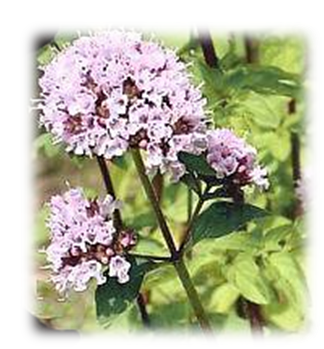


Marjoram - Origanum majorana (Labiatae - Lamiaceae, Mint family) Characteristics and uses:
Etymology: Marjoram was called "amaracum" in Latin (coming from the Greek "amarakos"). Marjoram's reputation as aphrodisiac herb in Roman literature is probably due to the similarity of amaracum to Latin "amor" (love), but it is linguistically not related. The name was additionally influenced by Latin "maior" (major, greater). Other uses: The flowering leaves and tops of marjoram are steam-distilled to produce an essential oil, rich in borneol, camphor and pinene. To enhance the digestive system's performance, 2 cups of marjoram tea are very useful. History and folklore: According to Greeks and Romans was a symbol of happiness. It was believed to repel witches' spell, goblins, ghosts, and the devil himself, if thrown over the threshold of a house, or hung over a doorway. In the language of flowers it is the herb of love: according to Roman and Greek legend, the goddess of love, Venus, (Aphrodite in Greek), liked it "to remind mortals of her beauty". For this reason a crown of marjoram was worn by the bride and groom during wedding ceremonies. Placing marjoram under a woman's pillow, before bed, Aphrodite would appear in a dream to reveal the future spouse's identity. ***** Erbe Matte cannot take any responsibility for any adverse effects from the use of plants. Always seek advice from a professional before using a plant medicinally***** ***** We carefully dry marjoram stems when they are crisp, at the first bloom; after they are dried out, we remove the leaves and flowers by sliding our fingers down each stem. ***** |
 It is a perennial, evergreen herb, having a sweet pine and citrus flavours. In some middle eastern countries, marjoram is synonymous with oregano. It is indigenous to Cyprus, Egypt, Arabia and southern Turkey. Marjoram is cultivated for its aromatic leaves, either green or dry, for culinary purposes (sauces, salads, soups and meat dishes). Marjoram has many uses with numerous health benefits: antiseptic, antifungal, antibacterial and antiviral. When used regularly, marjoram is a great addition: one tablespoon is packed with antioxidants, vitamins (A and C) and important nutrients, such as calcium and especially iron.
It is a perennial, evergreen herb, having a sweet pine and citrus flavours. In some middle eastern countries, marjoram is synonymous with oregano. It is indigenous to Cyprus, Egypt, Arabia and southern Turkey. Marjoram is cultivated for its aromatic leaves, either green or dry, for culinary purposes (sauces, salads, soups and meat dishes). Marjoram has many uses with numerous health benefits: antiseptic, antifungal, antibacterial and antiviral. When used regularly, marjoram is a great addition: one tablespoon is packed with antioxidants, vitamins (A and C) and important nutrients, such as calcium and especially iron. 